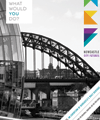May
Delve into Newcastle's past and help form its future

A grand plan to concrete over the River Tyne is one of the more intriguing stories being revealed at the Newcastle City Futures: People, Place and Change event next month.
This idea, which was mooted during the 1960s as an answer to reviving the derelict Quayside area, would have seen the river between what is now the Millennium Bridge and the Tyne Bridge filled in to make way for a new entertainment area, municipal centre and heliport.Ironically, the plans included an opera house-style building and an art gallery, which can be found on the Gateshead side of the river today. ?
But organisers are keen to point out that there’s more to this ambitious exhibition and events programme than a rose-tinted look into the past.
“We’re not just planning a historic look at the city,” says organiser Professor Mark Tewdwr-Jones, of Newcastle University. “The aim is to look at what we previously imagined the future to be and generate forward-looking discussions about where we go from here.
“What do we want Newcastle of the future to look like? We have never been afraid of thinking big and looking ahead in this city. There’s still confidence about our future and we want to build upon that, to create a discussion about what people living here want to see.”
Newcastle City Futures, which runs from 23 May-10 June at the Guildhall on Newcastle’s Quayside, will trace the development of the city’s built heritage and its constant state of renewal over the past 75 years.
It also marks the beginning of the city’s status as a ‘living laboratory’, finding new opportunities to engage with wider communities to help shape the NewcastleGateshead of the future. There will be the chance to see and debate key plans and frameworks being unveiled by Science Central, the city council, Nexus and Newcastle Airport which will affect Newcastle and its communities in the years to come.
Lord John Shipley, member of the Economic Affairs Committee of the House of Lords and leader of Newcastle City Council from 2006-2010, will be drawing on his experience as Government Advisor on Cities as one of the key speakers during the events series. Other speakers include Katja Leyendecker, chair of Newcastle Cycling Campaign, and several speakers from CURDS, the major research centre at Newcastle University for local and regional development.
Visitors to the exhibits will get the chance to look at many other un-built projects around the city and also examine artefacts such as concrete from Gateshead’s Get Carter car park and a manhole cover from a housing estate in Killingworth printed with a map because planners were concerned people living there would get lost.
There will also be family workshops and film screenings by the Amber Film and Photography collective, including a special screening of their experimental documentary about the scandal around corrupt politician T Dan Smith, the leader of the city council in the 1960s who had his own vision of making Newcastle ‘Brasilia of the North’.
Newcastle City Futures is supported by the Royal Town Planning Institute, Newcastle Institute for Social Renewal, Tyne and Wear Museums and Archives, the Royal Institute of British Architects and Newcastle University. Farrells, the architect planners who developed Newcastle Quayside, is also a supporter and Terry Farrell’s Geordie Ramblas model, a pedestrian network which would link key areas of NewcastleGateshead, will also be on display.
“This is a rare a chance to explore Newcastle’s heritage and reflect on the forces which shaped the city we have today while posing important questions about how the city and its people might want it to develop in the future,” said Professor Tewdwr-Jones.
Follow the blog or visit the website to find out more about the events.
published on: 1 May 2014
